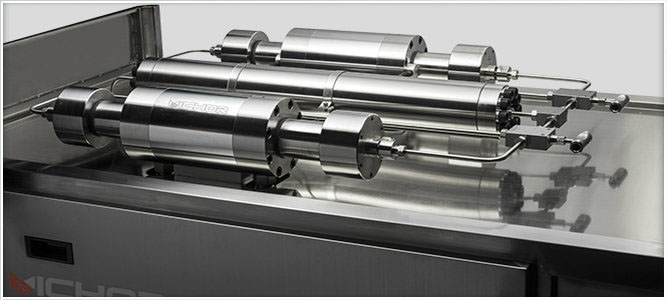
7 Key Facts About Hydraulic Intensifier Pumps: How Do They Amplify Power?
In the world of high-pressure fluid power, where standard hydraulic pumps reach their limits, a specialized device takes center stage: the hydraulic intensifier pump. This ingenious component is the key to unlocking extreme pressure levels that are otherwise unattainable with conventional systems. But what exactly is a hydraulic intensifier pump, and how does it achieve this power multiplication? This article delves into seven critical aspects of its operation, design, and application, providing a comprehensive understanding of this powerful technology.
What is a Hydraulic Intensifier Pump and Its Core Principle?
A hydraulic intensifier pump is a device that converts a large volume of low-pressure fluid into a small volume of high-pressure fluid. Unlike a standard pump, which generates flow and pressure directly from a prime mover, an intensifier uses an existing hydraulic power source to “intensify” or boost the pressure to a much higher level. The core principle is based on Pascal’s law and a simple force-balance equation: Pressure = Force / Area.
Imagine two pistons of different sizes connected by a common rod, housed within a single cylinder. The low-pressure fluid acts on the larger piston, creating a force. This force is transmitted directly to a smaller piston. Since the area of the smaller piston is significantly less, the same force results in a much higher output pressure. The fundamental relationship is: Output Pressure = Input Pressure × (Area of Large Piston / Area of Small Piston). This ratio is known as the intensification ratio.
The Inner Workings: How Does a Hydraulic Intensifier Pump Function?
The operation of a hydraulic intensifier pump is typically a two-stage, reciprocating cycle. Let’s break down the sequence:
Intensification Stroke: Low-pressure hydraulic fluid from the power unit enters the primary (large) chamber, pushing the large piston. This piston is directly linked to the small, high-pressure piston. As the assembly moves, the small piston pressurizes the fluid in the secondary (small) chamber to the intensified level, delivering it to the application, such as a clamp or cylinder.
Reset Stroke: Once the stroke is complete, the flow of low-pressure fluid to the primary chamber is redirected. Low-pressure fluid is now ported to the opposite side of the piston assembly, or a spring mechanism returns it, pushing the pistons back to their starting position. During this reset phase, the high-pressure output is typically stopped, and the circuit may be replenished with fluid from a low-pressure source.
This cycle repeats rapidly, providing a continuous, pulsating flow of high-pressure fluid. Modern intensifiers are often designed with multiple stages or tandem setups to smooth out these pulsations.
Key Advantages of Using a Hydraulic Intensifier Pump
The decision to integrate a hydraulic intensifier pump into a system is driven by several compelling benefits:
Extreme Pressure Generation: The most obvious advantage is the ability to generate pressures far beyond the capabilities of standard hydraulic pumps, often reaching thousands of bar (or psi).
Cost-Effectiveness: It is more economical to use a standard low-pressure pump paired with a hydraulic intensifier pump to achieve very high pressures than to invest in a single, massive, and expensive high-pressure pump unit.
Energy Efficiency: The system only intensifies the small volume of fluid needed for the high-pressure operation, saving energy compared to running a large, direct high-pressure pump continuously.
System Simplification: It allows for the use of standard, cost-effective components for the majority of the hydraulic system, reserving specialized high-pressure components only for the final output stage.
Common Applications and Industries That Rely on This Technology
The unique capability of the hydraulic intensifier pump makes it indispensable in numerous high-pressure applications across various industries:
Metal Forming: Used in hydroforming machines to shape metal tubes and sheets with high-pressure fluid.
Water Jet Cutting: Intensifiers are the heart of ultra-high-pressure water jet systems, creating pressures sufficient to cut through metal, stone, and composites.
Static Testing: Employed in pressure vessels and component testing rigs to simulate extreme operating conditions.
Clamping and Holding: Provides high holding force in fixtures and jigs with minimal cylinder size.
Powder Compaction: Used in industries to compress metal or ceramic powders into dense compacts.
Critical Design Variations: Single-Acting vs. Double-Acting Intensifiers
Not all hydraulic intensifier pumps are built the same. The primary design distinction lies in their cycling mechanism:
Single-Acting Hydraulic Intensifier Pump: This is the simpler design, as described in the “Inner Workings” section. It produces high-pressure fluid only during the intensification stroke. The reset stroke is a non-productive phase, often driven by a spring or a separate low-pressure signal. This results in a pulsating output.
Double-Acting Hydraulic Intensifier Pump: This more advanced design produces high-pressure output on both strokes of the piston. It essentially contains two high-pressure chambers, one on each side of the piston assembly. As one chamber is being pressurized on the forward stroke, the other is delivering high-pressure fluid on the return stroke. This design significantly reduces pressure pulsation and provides a more continuous flow.
Important Selection Criteria and Maintenance Considerations
Choosing and maintaining the right hydraulic intensifier pump is crucial for system longevity and performance. Key factors include:
Intensification Ratio: This determines the maximum output pressure for a given input pressure.
Flow Rate: The volume of high-pressure fluid delivered per cycle.
Compatibility: The materials of construction must be compatible with the hydraulic fluid and the operating environment to prevent corrosion and wear.
Filtration: High-pressure systems are extremely sensitive to contamination. Ultra-fine filtration is mandatory both on the input and output sides to prevent damage to the small orifices and seals within the hydraulic intensifier pump.
Seal Maintenance: The seals, especially on the high-pressure piston, are subject to extreme wear and must be monitored and replaced as part of a regular preventive maintenance schedule.
How Does a Hydraulic Intensifier Pump Compare to a Standard High-Pressure Pump?
While both devices deliver high pressure, their approaches differ fundamentally. A standard high-pressure pump, like a plunger or piston pump, generates pressure directly from a rotating shaft. It is designed to handle the full flow at high pressure, making it large, complex, and expensive for very high-pressure duties.
In contrast, a hydraulic intensifier pump is an add-on component that leverages an existing low-pressure system. It is more compact for the pressure levels it achieves and is often a more efficient solution for applications requiring a small volume of fluid at ultra-high pressure, rather than a continuous high flow.
Frequently Asked Questions (FAQs)
Q1: What is the main limitation of a hydraulic intensifier pump?
A1: The primary limitation of a hydraulic intensifier pump is its inherently pulsating flow, especially in single-acting designs. While double-acting models mitigate this, they do not eliminate it entirely. Furthermore, they deliver a relatively small volume of high-pressure fluid per cycle compared to the input flow, making them less suitable for applications requiring continuous, high-flow rates at high pressure.
Q2: Can a hydraulic intensifier pump work with any type of hydraulic fluid?
A2: No, compatibility is critical. While most hydraulic intensifier pumps are designed for standard mineral-based oils, specific models can be built for water, water-glycol mixtures, or other specialized fluids. The choice of seals and internal materials is directly dependent on the fluid type to ensure proper operation and prevent premature failure.
Q3: How is the output pressure of a hydraulic intensifier pump controlled?
A3: The output pressure is primarily determined by the input pressure and the fixed intensification ratio. Therefore, the most common and effective way to control the output pressure is by regulating the input pressure from the main hydraulic power unit, typically using a pressure relief valve or a proportional pressure control valve.
Q4: Why is filtration so critical for an intensifier system?
A4: Filtration is paramount because the internal clearances and seals in a hydraulic intensifier pump are subjected to extreme pressures. Even microscopic contaminants can cause abrasive wear, score the piston and cylinder walls, and lead to rapid seal failure, resulting in a catastrophic loss of pressure and costly downtime.
Q5: Is a hydraulic intensifier pump considered an energy-efficient component?
A5: Yes, in its intended application, a hydraulic intensifier pump is an efficient solution. It allows the main power unit to operate at a standard, efficient pressure level. Energy is only consumed to intensify the specific, small volume of fluid needed for the high-pressure task, rather than pressurizing the entire system flow to an extreme level, which would be far less efficient.
continue reading



